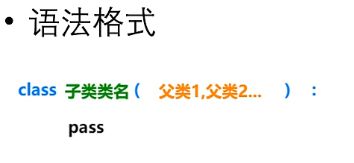面向对象的三大特征
目录
1.封装:(提高程序的安全性)
2.继承:(提高代码的复用性)
3.方法重写
4.object类
5.多态:(提高程序的可扩展性和可维护性)
6.静态语言和动态语言关于多态的区别
7.特殊方法与特殊属性
特殊属性:
特殊方法:
8.类的浅拷贝与深拷贝
1.封装:(提高程序的安全性)
①.将数据(属性)和行为(方法)包装到类对象中。在方法内部对属性进行操作,在类对象的外部调用方法。这样,无需关心方法内部的具体实现细节,从而隔离了复杂度。
②.在python中没有专门的修饰符用于属性的私有,如果该属性不希望在类对象外部被访问,前面使用两个"_"。
"-------面向对象的三大特征---------"
"---------封装----------"
class Car:
def __init__(self, brand):
self.brand = brand
def start(self):
print('汽车已启动......')
car = Car('宝马X5')
car.start()
print(car.brand)
class Student:
def __init__(self, name, age):
self.name = name
self.__age = age # 年龄不希望在类的外部被使用,所以加__
def show(self):
print(self.name, self.__age)
stu1 = Student("张三", 20)
stu1.show()
### 在类的外部使用name与age
# print(stu1.name, stu1.__age) # AttributeError: 'Student' object has no attribute '__age'
print(dir(stu1))
print(stu1._Student__age) # 在类的外部可以通过_Student__age访问
2.继承:(提高代码的复用性)
如果一个类没有继承任何类,则默认继承object
python支持多继承
定义子类时,必须在其构造函数中调用父类的构造函数
"-------面向对象的三大特征---------"
class Person(object):
def __init__(self, name, age):
self.name = name
self.age = age
def info(self):
print(self.name, self.age)
class Student(Person):
def __init__(self, name, age, student_number):
self.student_number = student_number
super().__init__(name,age)
class Teacher(Person):
def __init__(self,name,age,seniority):
super().__init__(name,age)
self.seniority = seniority
stu1 = Student('张三', 20, 2165161163)
teacher1 = Teacher('徐四', 50, 25)
stu1.info()
teacher1.info()
##########################################
# 多继承
class A(object):
pass
class B(object):
pass
class C(A, B):
pass
3.方法重写
如果子类对继承父类的某个属性或方法不满意,可以在子类中对其(方法体)进行重新编写
子类重写后的方法中可以通过super().XXX()调用父类中被重写的方法
class Person(object):
def __init__(self, name, age):
self.name = name
self.age = age
def info(self):
print('姓名:{0},年龄:{1}'.format(self.name, self.age))
class Student(Person):
def __init__(self, name, age, student_number):
super().__init__(name, age) # super().xx()调用父类的name 与age
self.student_number = student_number
def info(self):
super().info() # super().xx()调用
print('学号', self.student_number)
class Teacher(Person):
def __init__(self, name, age, seniority):
super().__init__(name, age)
self.seniority = seniority
def info(self):
super().info() # super().xx()调用
print('教龄', self.seniority)
stu1 = Student('张三', 20, 202161223010)
teacher1 = Teacher('李四', 45, 25)
stu1.info()
teacher1.info()4.object类
object类是所有类的父类,因此所有类都有Object类的属性和方法
内置函数dir()可以查看指定对象所有的属性
object有一个_str_()方法,用于返回一个对于"对象的描述",对应于内值函数str()经常采用print()方法,帮我们查看对象的信息,所以我们经常会对_str_()进行重写
class Student:
pass
stu=Student()
print(dir(stu)) # dir()可以查看stu具有的属性和方法
# 这些属性都是从object继承过来的
print(stu) # 输出的是对象的内存地址
class Student:
def __init__(self,name,age):
self.name = name
self.age = age
def __str__(self):
return '我的名字是{0},今年{1}岁'.format(self.name,self.age)
stu = Student('张三',20)
print(stu) # 重写str之后,默认调用str的方法
print(type(stu))5.多态:(提高程序的可扩展性和可维护性)
它指的是:即便不知道一个变量所引用的对象到底是什么类型,依然可以通过这个变量调用方法,在运行过程中根据变量所应用的对象,动态决定调用那个对象中的方法
class Animal(object):
def eat(self):
print('动物会吃')
class Dog(Animal):
def eat(self):
print('狗吃骨头.....')
class Cat(Animal):
def eat(self):
print('猫吃鱼')
class Person(object):
def eat(self):
print('人吃五谷杂粮')
def fun1(obj):
obj.eat() # 定义函数,调用eat()方法
fun1(Person()) # Person()跟Animal(),Dog(),Cat()没有继承关系,但是Person有eat()方法,所以也会调用
fun1(Cat()) # 调用函数
fun1(Dog())
fun1(Animal())
6.静态语言和动态语言关于多态的区别
静态语言实现多态的三个必要条件:继承,方法重写,父类引用指向子类对象
7.特殊方法与特殊属性
特殊属性:
# print(dir(object))
"------类中的特殊属性-------"
class A:
pass
class B:
pass
class C(A,B):
def __init__(self, name,age):
self.name = name
self.age = age
class D(A):
pass
x = C('jack', 20) # x是C类的一个实例对象
print(x.__dict__) # __dict__ 可以获得绑定的实例属性字典
print(C.__dict__) # __dict__可以获得绑定的类对象的实例属性和方法的字典
print('-'*100)
print(x.__class__) # 会输出对象所属的类
print(C.__bases__) # 输出的是C类的父类 ,类型为元组
print(C.__base__) # 跟C离的最近的父类 ##class C(A,B):,这里要是改为C(B,A)输出的就是A
print(D.__mro__) # 查看的是类的层次结构
print(A.__subclasses__()) # 查看的是A的子类元素 输出类型为列表
特殊方法:
①__add__()
a = 20
b = 30
c = a + b # 两个整数类型的对象的相加操作
d = a.__add__(b)
print(c, d)
# 自定义类型的相加操作
class Student(object):
def __init__(self, name):
self.name = name
def __add__(self, other): # 为了让两个对象相加,编写了__add__()方法
return self.name+other.name
stu1 = Student('张三')
stu2 = Student('李四')
print(stu1+stu2) # 实现了两个对象的加法运算,因为在Student类中,编写了__add__()特殊方法
print(stu1.__add__(stu2))②__len__()
# 自定义类型的相加操作
class Student(object):
def __init__(self, name):
self.name = name
def __add__(self, other): # 为了让两个对象相加,编写了__add__()方法
return self.name+other.name
def __len__(self): # 编写了__len__()方法,返回值为self.name的长度
return len(self.name)
stu1 = Student('jack')
stu2 = Student('李四')
lst = [10,20,30,40]
print(len(lst)) # 使用的是内置函数len()
print(lst.__len__()) # 使用的是__len__()方法
print(stu1.__len__())③__new__()和__init__()
class Person(object):
def __new__(cls, *args, **kwargs):
print('__new__被调用了,cls的id值为{0}'.format(id(cls)))
obj = super().__new__(cls)
print('创建对象的id为:{0}'.format(id(obj)))
return obj
def __init__(self, name, age):
self.name = name
self.age = age
print('__inti__方法被调用了,self的id值为{0}'.format(id(self)))
print('object类对象的id值为{0}'.format(id(object)))
print('Person类对象的id值为{0}'.format(id(Person)))
# 创建person类的实例对象
p1 = Person('张三', 20)
print('p1是Person类的实例对象,其id值为{0}'.format(id(p1)))
##### 结果
"""
object类对象的id值为140736655214464
Person类对象的id值为2133173128064
__new__被调用了,cls的id值为2133173128064
创建对象的id为:2133181899744
inti方法被调用了,self的id值为2133181899744
p1是Person类的实例对象,其id值为2133181899744
"""
"""
程序先执行Person('张三', 20)----然后传给了cls
----调用的时候传到object中然后创建了对象obj
然后return返回给了self,然后将self传给p1
"""8.类的浅拷贝与深拷贝
变量的赋值操作:只是形成两个变量,实际上还是指向同一个对象
浅拷贝:python拷贝一般都是浅拷贝,拷贝时,对象包含的子对象内容不拷贝,因此,源对象与拷贝对象会引用同一个子对象。
深拷贝:
使用copy模块中的deepcopy函数,递归拷贝对象中包含的子对象,源对象和拷贝对象所有的子对象也不同。
import copy
class Cpu:
pass
class Disk:
pass
class Computer:
def __init__(self,cpu,disk):
self.cpu = cpu
self.disk = disk
# 变量的赋值
# 其实是cpu1类指针指向Cpu类对象,cpu2只是被cpu1赋给value,但是id还在cpu1
cpu1 = Cpu()
cpu2 = cpu1
print(cpu1, id(cpu1))
print(cpu2, id(cpu2))
# 类的浅拷贝
# python拷贝一般都是浅拷贝,拷贝时,对象包含的子对象内容不拷贝,因此,源对象与拷贝对象会引用同一个子对象。
# 可以看到computer与computer2内存是不同的,但是computer.cpu与computer2.cpu,computer.disk与computer2.disk内存是一样的
disk = Disk() # 创建一个硬盘类的对象
computer = Computer(cpu1, disk) # 创建一个计算机类的对象
computer2 = copy.copy(computer)
print(computer, computer.cpu, computer.disk)
print(computer2, computer2.cpu, computer2.disk)
# 深拷贝
# 使用copy模块中的deepcopy函数,递归拷贝对象中包含的子对象,源对象和拷贝对象所有的子对象也不同。
computer3 = copy.deepcopy(computer)
print(computer, computer.cpu, computer.disk)
print(computer3, computer3.cpu, computer3.disk)


